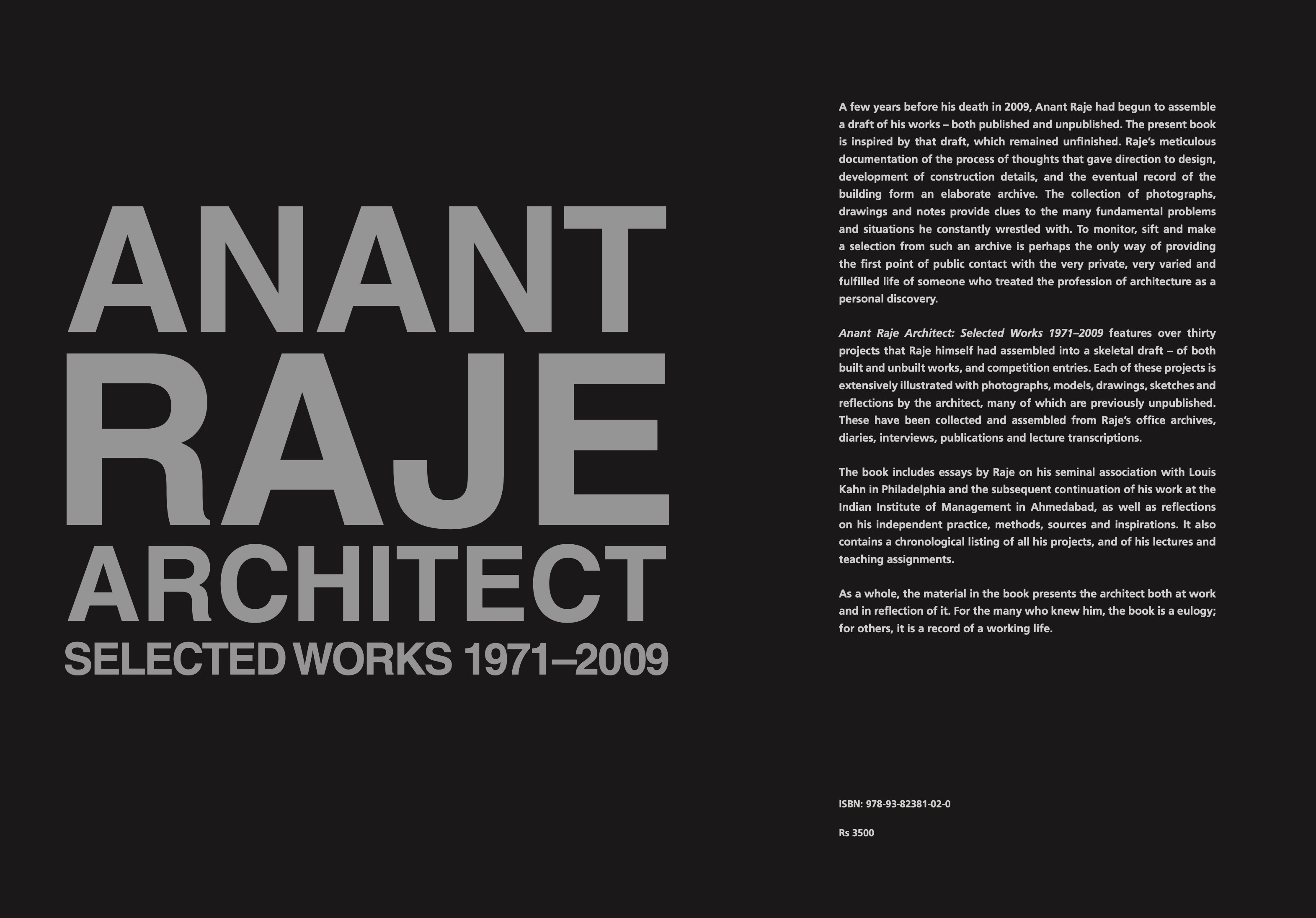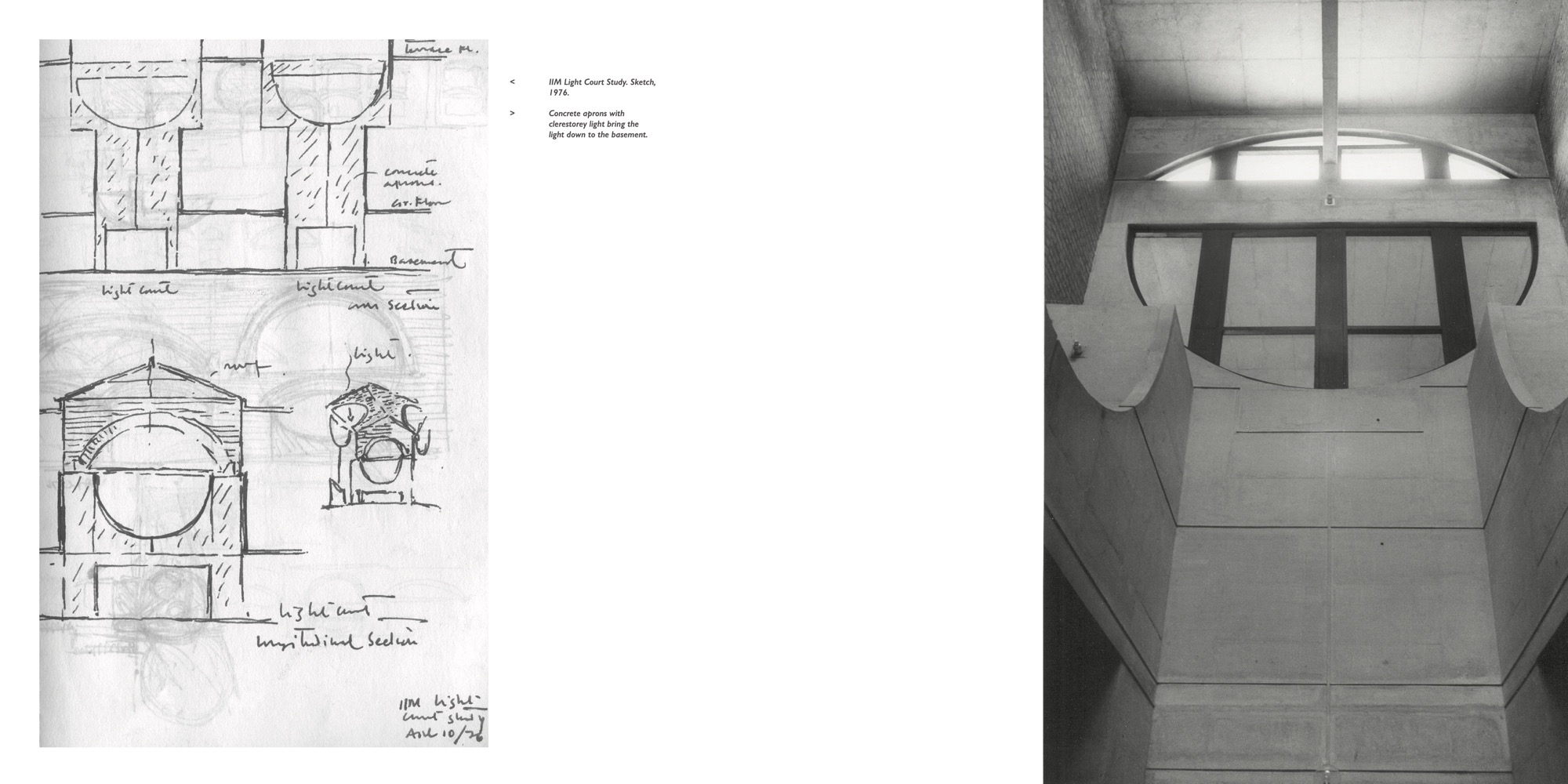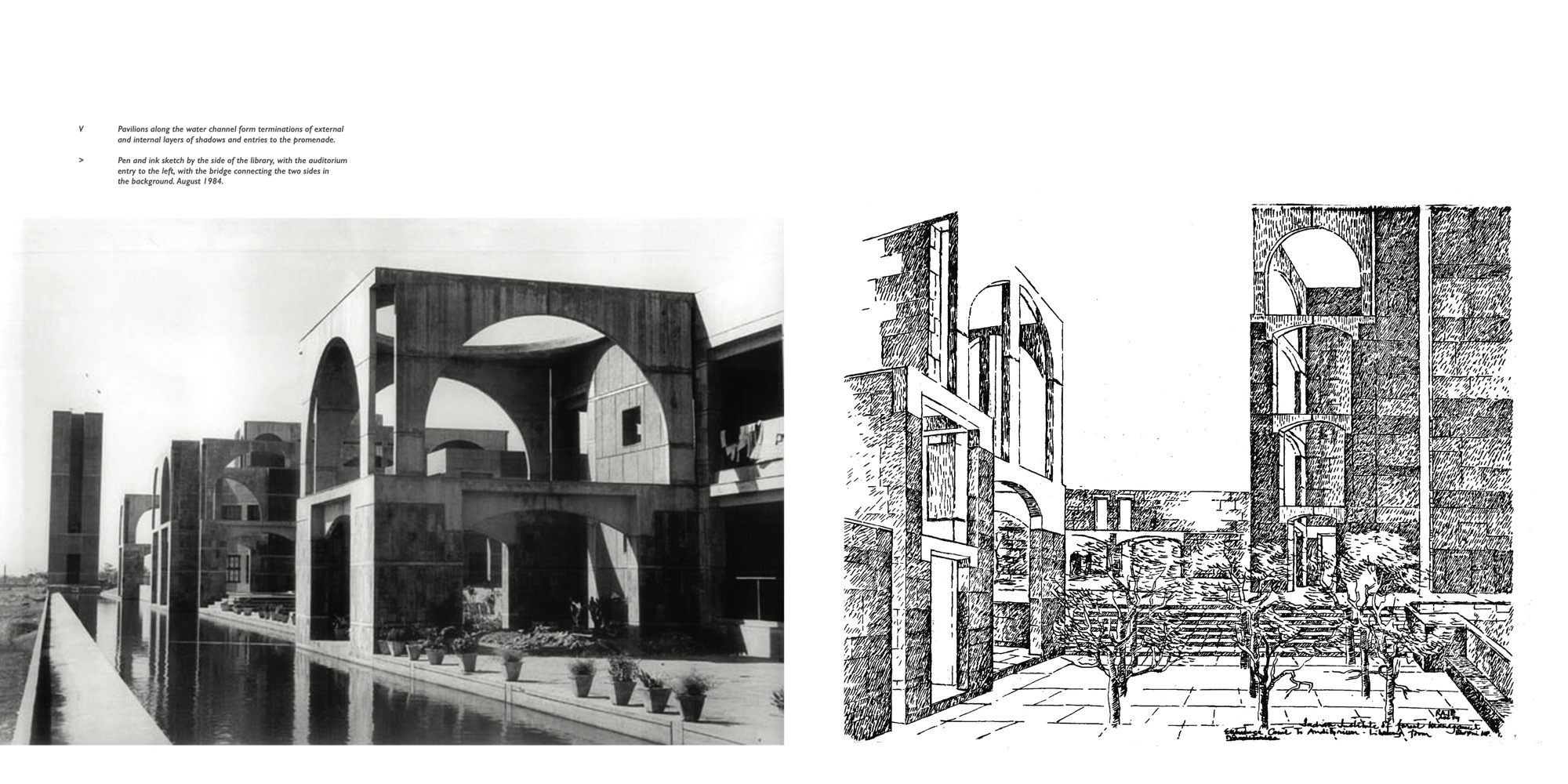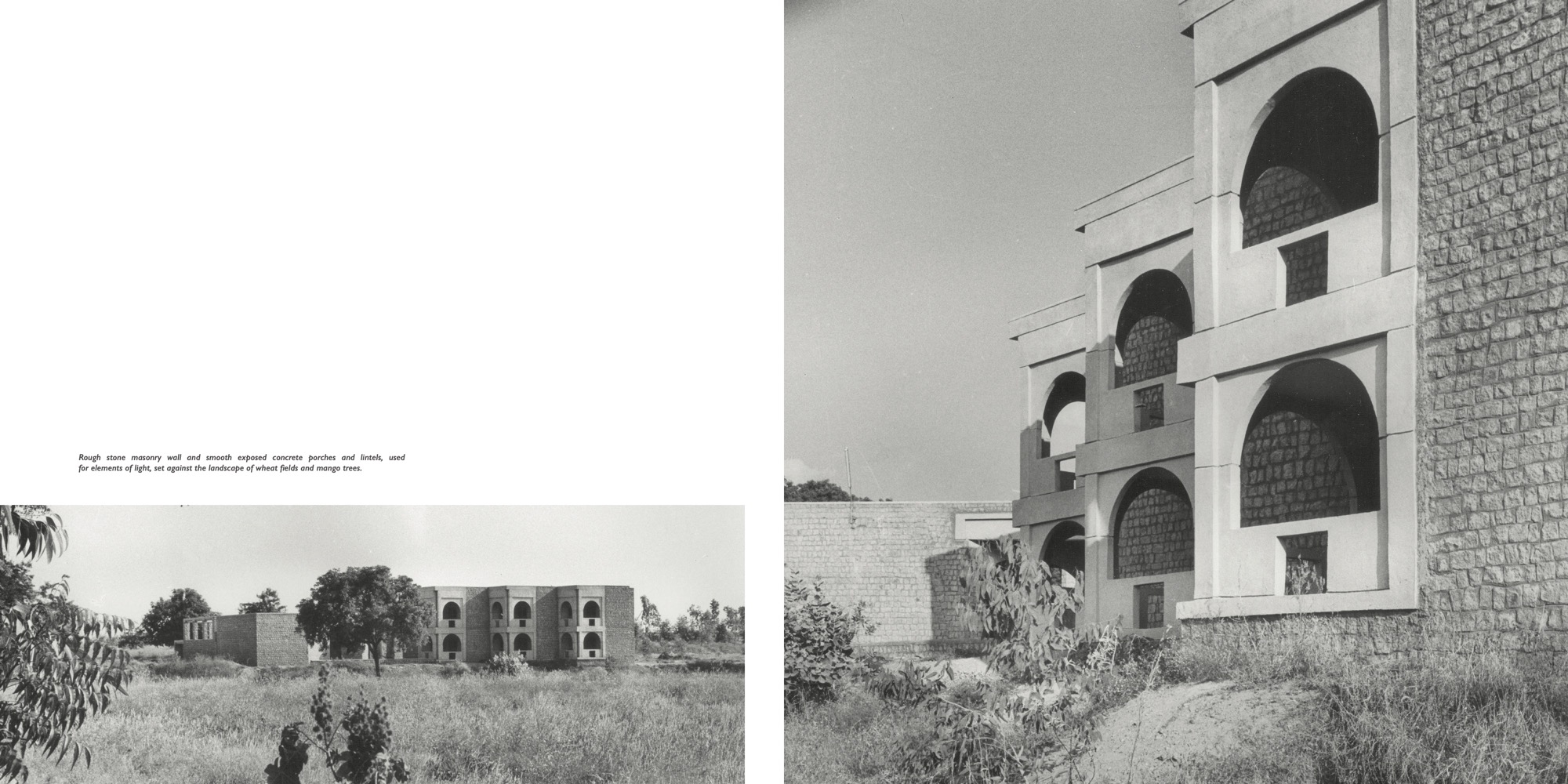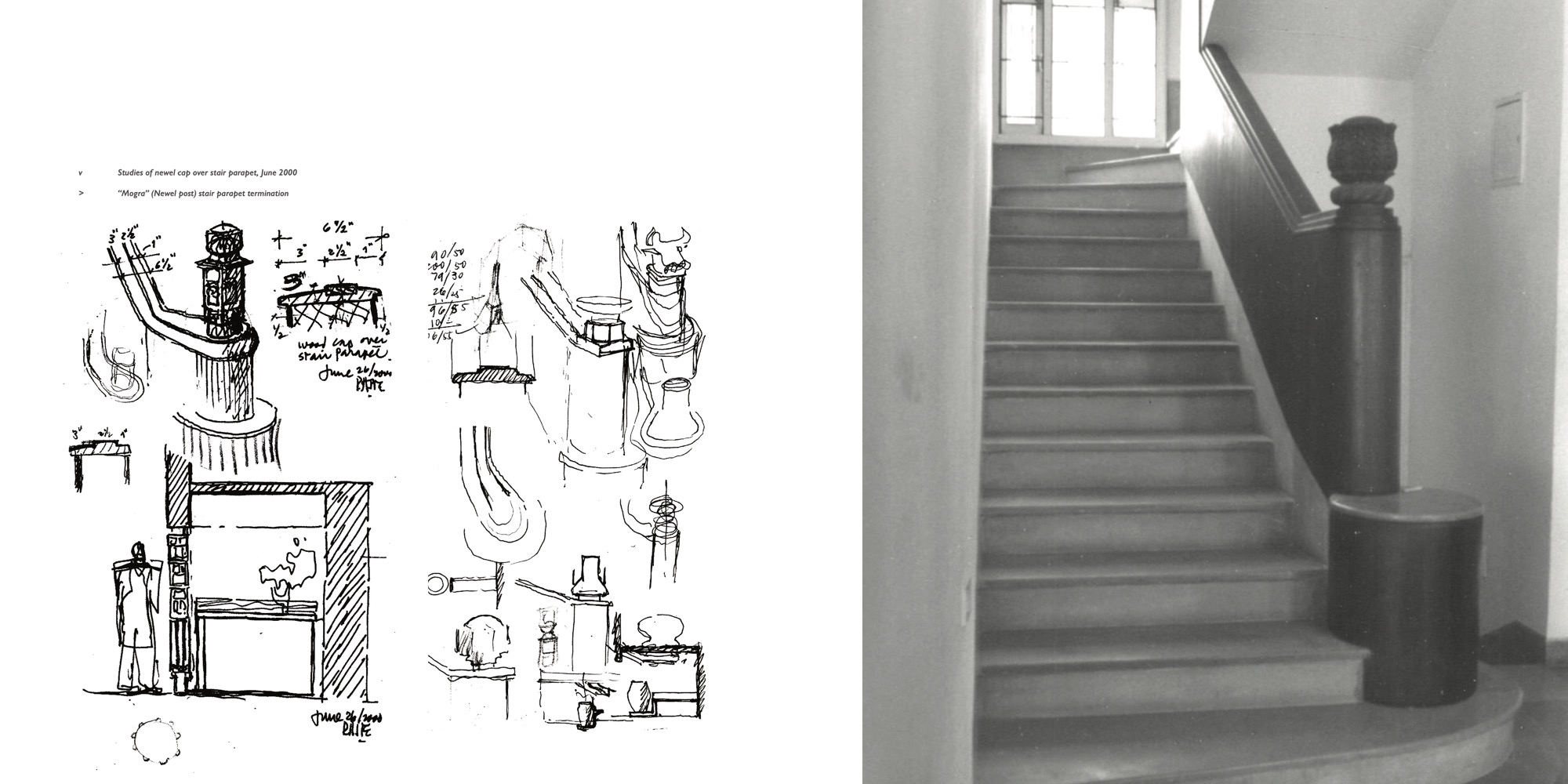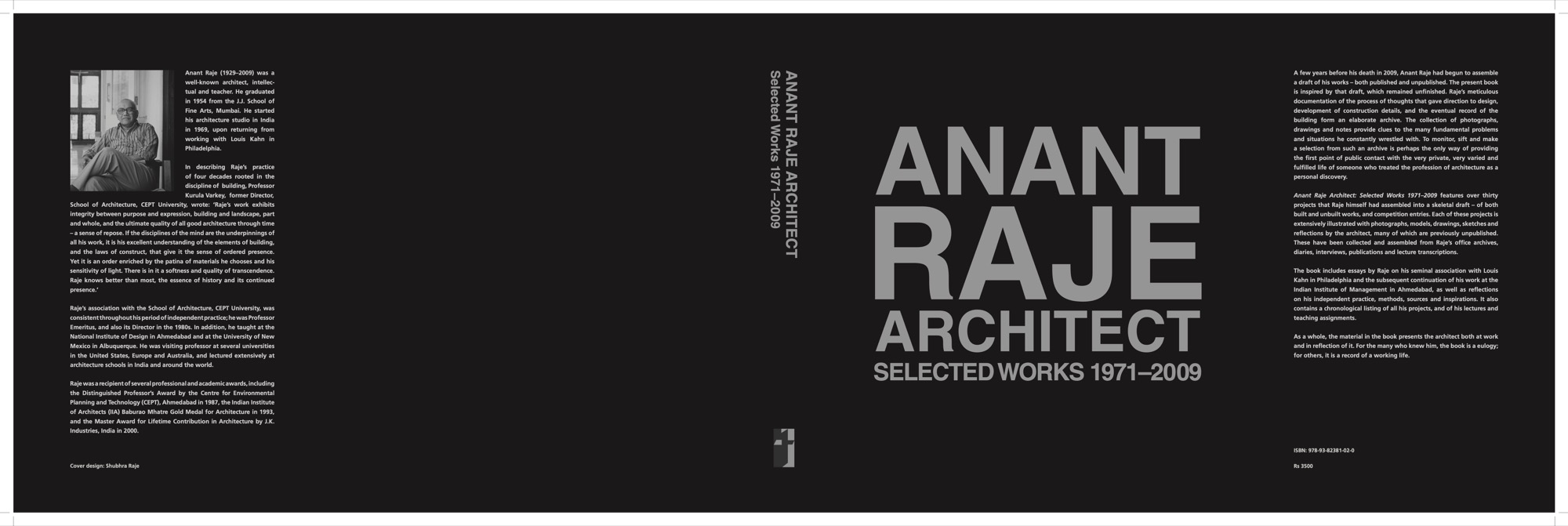
Buy the book from :
AMAZON INDIA or Anant Raje Foundation
Introduction
In order to live we ‘have to be free of the authority of our immediate predecessors’, wrote D.H. Lawrence. Anant Raje was a free man. His long association with Louis Kahn, from 1964 to 1974, and later, the twenty-six years as project architect for the Indian Institute of Management at Ahmedabad, were his first call to free- dom. The rigorous link to Kahn, paradoxically, provided Raje with a significant platform for thinking freely – and enacting architecture in a larger frame of understanding that came from life itself. Such a view emancipated Raje from the narrow, cloistered, problem- solving bent of conventional practice, and laid before him a fer- tile plain of immense and limitless prospects. In eventually work- ing out ideas, each project began as an equation between infinite possibility and architectural containment, within which lay all the pertinent questions about modernity and tradition, the role of history, the need to extend the masonry tradition, and to search for an inherent order beyond the merely visible, the literal and the prescriptive. Indeed, the move away from a pictorial outlook was realized in the conventions of elevations, facades, and all the lies and evasions by which ordinary architecture nourished itself. In an examination of a lifetime of work, it is hard now to pinpoint precise inspirations and influences. Doubtless there were many.
In a large part, the serious problem of the archi- tect in India has been the unresolved conflict between pri- vate attitude, professional conduct and public expectation. At a personal level there remains the perpetual need to evaluate and assert your self-worth by being formally creative; profes- sional demands necessitate mediocrity and conventions as pri- mary value givers of acceptable architecture; the public mean- while forms its opinions through visibility and experience. Acting together, the three forces have produced some serious misgivings in the profession and an unfortunate dreariness in the surroundings.
Within such an environment, Raje was an independent interpreter, an introvert – partly because of his reluctance to adapt to the methods of conventional practice. While his peers played within the ordinary vocabulary of the tested architectural alpha- bet, Raje refused to be enslaved by the visible, comprehensible language of buildings around him. He built only for himself, urg- ing others around him to respect the privacy of his thoughts. In so doing, he created a counter-reality of his own, something suited to his own artistic rather than professional temperament. The grow- ing detachment was palpable in a world which derived continual sustenance from public recognition. In that world he was a happy misfit, even distancing his work from the mundane vocabulary of daily inducements and regular backpats. Over the years, in the fifty years of thinking, drawing and constructing, once he was comfortable with his own methods and explorations, he had even ceased to try and make peace with his profession.
Instead, Raje engrossed himself in his own expression – an engagement with the spirit of a personal architectural life. As a practitioner he was forever aware of the principles of time and place, but used them ahistorically, as the eternal ‘now’. The ‘now- ness’ of phenomena was essential to the passionate enthralment of all experience. To live was to be constantly and joyously aware, without the stifling apprehension of morality and convention. Raje opened up to all sources of cultural and intellectual nourishment – music, film, building, art, writing, dance, theatre, science, astron- omy, even cricket. Indeed, to life itself. Listening to a piece of music once, he remained absorbed in its notes and, only when it was over, remarked, ‘it seems to be coming from a great distance’. The casual statement had nothing to do with the composition itself, but it demonstrated an immediate and deeper comprehension of the piece, as something being performed in great space; at once, the construction of the music acquired a different, architectural strain. Aware always of the changing phenomena that suffused and surrounded all action, it was neither an analytical nor a static or logical interpretation, but merely the expression of a moment – Raje’s private moment of connection and clarity.
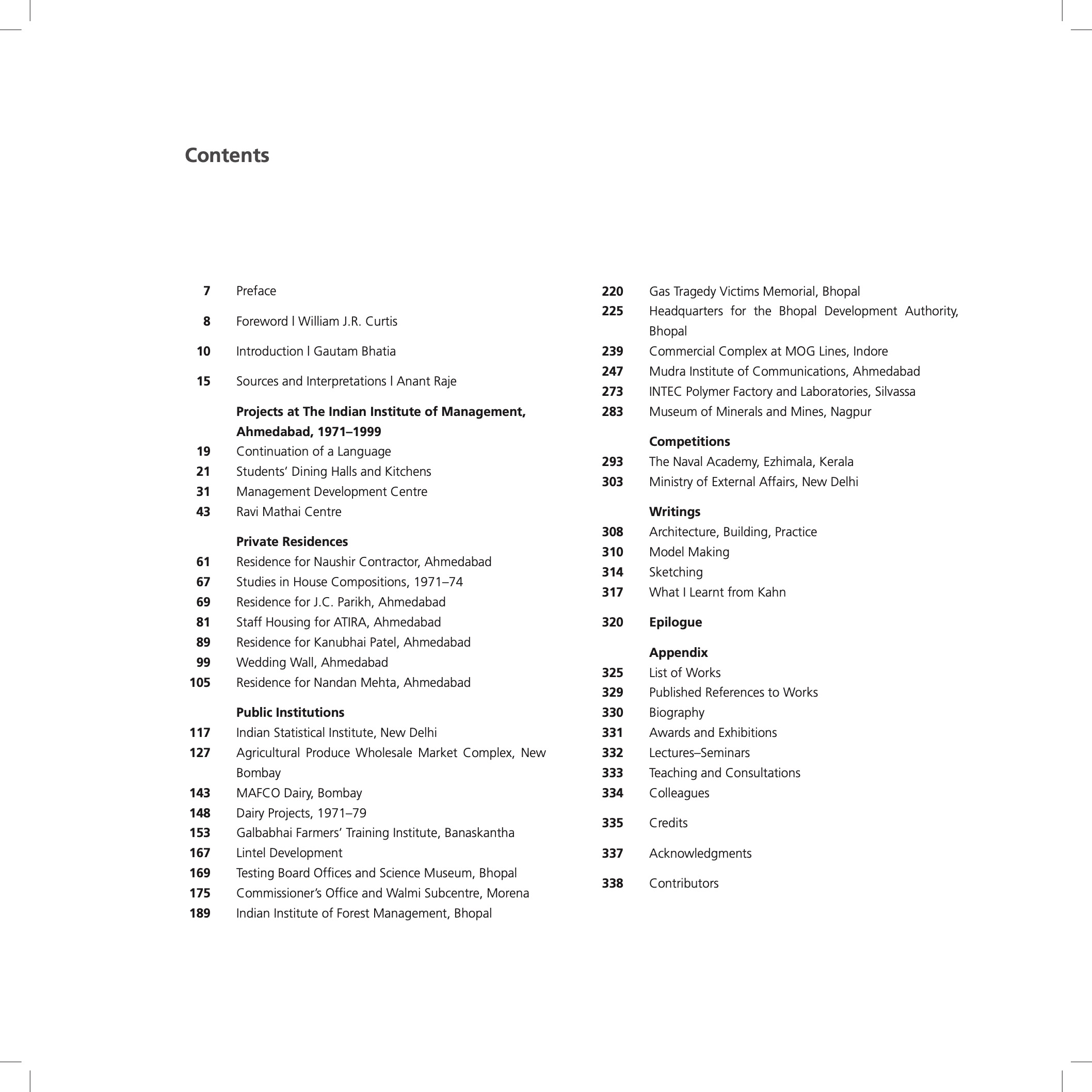
In the life of most architects, the city of their residence often fuels the embers of architecture. For Kahn it was Philadelphia, for Vitruvius, Rome. Raje’s fifty-year-long association with Ahmedabad remained an unfulfilled, clinical detachment. The place provided him the source of practice and teaching. How- ever the city’s suburban makeshift character, its thoughtless plot- ted development, left Raje to continue his sustaining links with Bombay (now Mumbai), where he had studied and worked in his early years. He knew the fabric of south Bombay intimately, walk- ing about its galis, conducting workshops and student exercises within the urban congestion seething with humanity.
It was there, amidst the tumult of a changing cityscape, that he learnt the larger lessons of Indian urbanism, observing how streets were made, how edges between landscape and architec- ture were reconciled, indeed how buildings linked to each other, how in fact proximities and overlaps of structures made geometric relationships in space possible. Against the backdrop of such a beginning, it is not unusual to test the many geometric manipula- tions and collisions that took place in the development of building plans. At the Indian Institute of Forest Management (IIFM) and in later additions to the Indian Institute of Management (IIM), Ahmedabad, the angular fusions of walls are reminiscent of the accretions of a Roman plan – a Pirenesian assembly built in the restructuring of a ruin. The multiple layers attributed to circum- stantial conditions in the Bombay streetscape here create private spatial dimensions. An urban street logic was applied to suggest the multiple layers of building functions. Because building context was absent on an empty site, the architect made his own, within the given constraints of the requirements. But by no means was it superfluous geometry for its own sake. The joining suffused with sudden moments of captive space and episodic possibility that went far beyond the stated building requirement, as in the IIFM library.
Unlike architects who use geometry as an organizing fea- ture of the plan, Raje willed disturbances and distortions into the mix that challenged or restated geometry. Sometimes, so desper- ate was the urge to redefine the urban character of space, even remote individual projects formulated new attitudes to their sur- roundings. In places where campus buildings were conventionally viewed as autonomous objects floating freely in space, he used a skilled urbanism to create their position in space, before anchor- ing them. Such an idea of a plan made up of a variety of cellular accretions was part of an intuitive grasp of connections and expo- sures that came directly from the inner recesses of the architect. At the Mudra campus the conference building turns upon its axis, as does the assembly hall of the Mathai Centre at the IIM. The Romanesque joinings and subtle inflections announce the clear importance of one function above another. Moreover, the accidental overlaps and collisions were part of the ‘mysterious’ inclina- tion of the architect to forever extend space beyond established requirements.
So too it was with landscape. At the IIFM complex the remote hill site required monumental links and heroic axial geo- metries to make far-off connections, across terrain and landscape, to the surrounding lake. Whole hills and waterways were first brought into play in an architecturally inconceivable expanse. Only after the effort at such an epic anchoring could the more inti- mate, internal architecture of the Institute begin. Unable to find landscape variants in the competition for the Indian Administrative Service Academy, Raje similarly proposed a range of high plinths to situate buildings. In the bleached, featureless flatness of Haryana without outcrop or treeline, architecture was ordered out of a self- made terrain.
Connection to space as abstract and symbolic also extended to the architect’s understanding of history. An integration of historic themes, though never consciously sought, was the natural outcome of a mind immersed in many classical tradi- tions, including the Islamic geometric ideals of Persia, Turkey and, of course, India. Raje’s use of these in his own work belies any direct visual links to monuments and ruins. It could be said that he derived a great deal of structural sustenance from the ruins of Mandu and Rome; so understated is the connection that equally it could be stated that the architects of Mandu foresaw their build- ings’ links to the future ruins of Morena and the Institute of Forest Management. The abstract nature of the inspiration does not leave the viewer gasping in supercilious delight but merely invested with a sensory evocation across the centuries, a slight disturbance in the mind’s eye. If, as Kahn noted, ‘in a blade of grass was the history of the universe’, the architecture of masonry with stud- ied openings, ruthless in its rhythms, could itself suggest a whole continuum of cultural development – a range within which the primitive and the civilized can exist together. The importance of relieving the building of the burden of expressing the time within which it was built was the only way to suggest the very essential ‘eternal’ of architecture. For Raje, the eternal was a nameless con- dition to which all his architecture adhered faithfully. Everything need not be stated. As in music, the absences in a building, like extended silences between musical notes, were the missing links to memory and association. The mind contemplated what the eye saw, in much the same way that a ruin allows you to complete the missing parts in your own image.
As much as possible, Raje stayed away from the illusory architectural practice of comfort and security and painlessness. Never self-consciously belonging to the profession, he was freed of the fear of failure. He readily relinquished its built-in profes- sional supports and possessions, and battled away headlong in a daily personal quest. With or without commissions, his pencil rarely fluctuated, the mind never wavered; projects were rarely the sin- gular sources of sustenance, only the mystical dimension of some personal discovery was. And from that there was no escape, no compromise; the daily quest was much too fulfilling, charged with intimate experience, with more tests, more experiments and con- tinual acts of faith. Every day he moved towards a new unknown, into a territory he created for himself. There was almost a stern engagement with destiny being played out each day – a sudden but partial revelation of an idea discovered in a model or held cap- tive in a sketch. The goal was however always elusive. Raje moved tirelessly towards it, animated by his own drive and the multitude of draughtsmen and model makers that promoted every minus- cule inclination towards an idea, towards coherence.
By adopting a private method for a public practice, Raje made a studio world which he dominated. In the large, airy room of multiple drawing boards he was the sole arbiter of power and authority, tolerating only the dictates of his own methods. The stu- dents he employed merely acted as the artist’s extra hands. There the cumulative effort of architecture was assessed in a private col- lective of thoughts, ideas, sketches and model assemblies. The eventual measure of success was not the final product of construc- tion, completed – but in the successful conclusion of the journey itself. Built or unbuilt, the project was merely the testing ground, a vigorous imaginative world he created for himself out of real situ- ations. The drama lay as much in the testing of those ideas in the studio as on the real construction site. The tireless chipping away, testing, redrawing and correcting were part of a temperament that refused to settle with partial resolutions; that he built much more in his mind was but expected. Raje’s consequent significance in the culture of thought and idea more than made up for his rela- tive insignificance in conventional practice.
Again and again, the dimensions and material aspects of design called for exploration. Precise elements of structure
would appear – attachments of porches, integration of landscape – requiring constant testing and refinement. The process was as deliberate and practical as it was personal and intuitive. It appeared everywhere: at the government headquarters at Morena, at the Museum of Mines and Minerals, even in the rarefied atmosphere of the Gas Tragedy Memorial. Elements were distilled and refined to a point of jewel-like iridescence, as if – as in the concrete lintel at Galbabhai Institute and again at the Mudra Institute of Commu- nication – their singular presence was the defining moment of the architecture. As long as the precision was clearly enacted in form and material, it could be expressed in a myriad of changing cir- cumstances. The lintel, the membrane arch, the independent light well, the screen wall, all became instruments in different projects. The personal struggle lay in discovering the physical form of each element before giving it application. Yet, despite the long process of model-making, sketching and note-taking, the elemental qual- ity was all included in the search, the eventual outcome merely a lesson in rigour and patience.
Spreads from the book:
Hard as it is to draw parallels in a work so independent, the nearest is perhaps Claude Batley, an architect whose reading of Indian traditional architecture Raje admired. Batley’s struggle to reconcile the wide arc of Indian architectural history with the emerging international style found due sympathy and resonated with his own compulsions. Again, being both a teacher and a prac- titioner, Raje directed both towards similar ends. In the classroom the serious train of inquiry was made into a situation of play, allud- ing, as he did with his students, to specific moments in architecture from day-to-day situations: the curve of a stair, the afternoon light catching a wall, reflections in water, the fleeting piercing sound in a tunnel. The easily recognizable moments shared, pondered and dwelt upon as precursors to architectural ideas dissolved the dif- ficult borders of prescriptive lessons, and evoked in class personal and indeed inspirational visual memories – both of his favoured city and his own days as a student.
Though he was forced to organize his thoughts and com- municate them in a logical sequence, Raje used the classroom to vent his intuitions through young, supposedly experimental minds. Of his students, he said, ‘I have forty minds to give me ideas.’ Each class was a form of improvisation more akin to classical music than architecture. Always aware of the applied structure of notes, the music was open to many interpretations. It struck the chord of a thoughtful, fluent storyteller, rather than a grave and dog- matic professor. This is not to suggest an inability to academically engage; on the contrary, because of the personal fluent beginning developed with a striking spirit, the themes threw up unexpected and lyrical resolutions. Neither nostalgic nor sentimental, the pro- cess was always logical, much like the discovery initiated in his own workplace. ‘Because I never discuss the outcome with the students, I am always surprised by the result.’
In a career that spanned sixty years, never was there space for the merely logical, the static or the analytical, and all the minor forces and conventions of architecture. Till the very end of his life Raje remained an astute and always enquiring student of architecture. In his late seventies, when he was asked to be the judge of a national architectural competition, his prompt reply was: ‘What! Do you think I am too old to compete?’
The great penumbra of Raje’s life exists outside a profes- sion that eluded him, that left him to his own devices. And yet the prime difficulty such a life poses to chronological record is partly due to the acute obscurity necessary for creative work, and the secretive artistic urge within which Raje lodged himself. ‘All artists have their secrets’, he used to say. ‘Their process is very precious to them.’ The contradictory nature of such an existence makes the record of a life both impossible and wholly worthy of enu- meration. For a man whose diligence of record – diaries, sketches, notebooks – was personal, and as much an attempt to explain life for himself as himself to life, a book on his work for public con- sumption was anathema.
Raje’s obsessive record of the process of his sketches and thoughts that gave eventual direction to design, the meticulous development of construction details, and the eventual record of the building, is in itself a distressingly elaborate archive to place before the public. The collection of photographs, drawings and notes may be inadequate in clarifying his ideas, but together they do provide clues to the many fundamental problems and situa- tions he constantly wrestled with. To monitor, sift and make selec- tive pickings from such an archive is perhaps the only method of providing the first point of public contact with a very private, very varied and fulfilled life.
The need to perennially redefine architecture was a per- sonal score for someone who treated the profession as a private discovery. It is hard enough to introduce the book of an enigmatic artist; it is harder still to do so, so close to his passing. Raje died in 2009. For the many who knew him, the book is a eulogy; for the others, a record of a working life.
Gautam Bhatia
// with contributions from Rahul Mehrotra, Amita Raje and Shubhra Raje
April 2012

